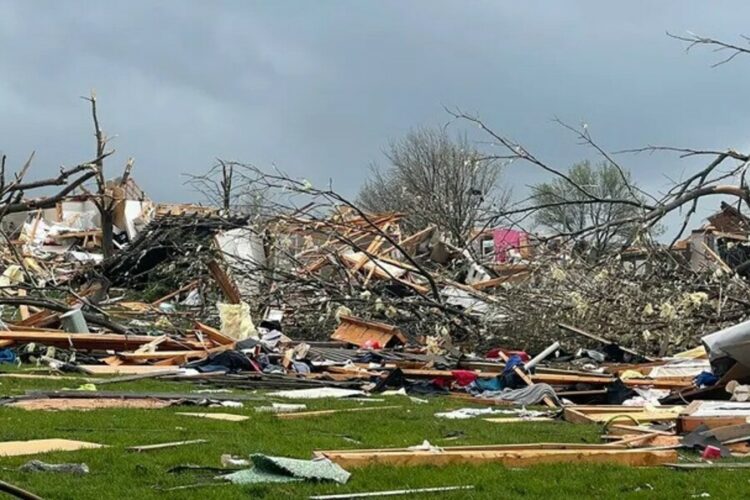Over the past week, the U.S. Heartland has faced a terrifying surge of severe weather, resulting in a devastating series of tornadoes that tore across multiple states, leaving widespread destruction in their wake. This extraordinary meteorological event has affected millions, from Texas to Iowa, underscoring a dramatic week of climatic upheaval.
As the week unfolded, the National Weather Service (NWS) confirmed the presence of more than 59 tornadoes across Texas, Oklahoma, Kansas, Nebraska, and Iowa. These tornadoes brought with them not just ferocious winds but also large hail and threats of severe flooding, putting approximately 20 million Americans on high alert.
Initial Impact And Response
The storms began to intensify early in the week, with weather models predicting significant atmospheric instability. By Friday, over two dozen tornadoes had already been reported, marking the onset of what would become a harrowing period for the residents of the Plains. Among the most affected was Nebraska, where a “large and destructive” tornado devastated communities, leading the NWS in Omaha to issue a rare tornado emergency for the area.
In Omaha, the impact was visceral. Several homes were destroyed, their debris scattered by winds that at times exceeded 70 miles per hour. Local police and emergency services were stretched to their limits, rescuing trapped residents and responding to urgent calls for help. Omaha Police Chief Todd Schmaderer highlighted the effectiveness of the city’s warning systems, crediting them with preventing a greater number of injuries.
Industrial and Residential Damage
One of the most significant incidents occurred at Garner Industries in Lincoln, Nebraska. A powerful tornado struck the large manufacturing facility in the afternoon, causing part of the structure to collapse. This event trapped about 70 workers inside, prompting a frantic rescue operation that successfully evacuated everyone. However, three individuals were hospitalized with injuries sustained during the ordeal.
Damage was not confined to Nebraska. In Texas, particularly in the northeast, and central Kansas, residents reported damage to property and infrastructure. Tornado watches were declared across six states, including major urban areas like Dallas and Des Moines, Iowa, as the system moved northward.
Meteorologists have pointed to a particularly volatile mix of warm, moist air from the Gulf of Mexico colliding with cooler, dry air from the Rockies as the primary cause of the severe weather. This collision created optimal conditions for the development of supercell thunderstorms, which are known for their potential to spawn tornadoes.
Extended Threat and Ongoing Concerns
As the severe weather system advanced into the weekend, the forecast extended beyond the immediate tornado threat to include a series of significant meteorological challenges. Severe thunderstorms were anticipated to blanket the region, bringing with them heavy rain and the potential for significant flash flooding across a wide swath of the U.S. Heartland.
Cities such as Oklahoma City and Tulsa were spotlighted as particularly vulnerable, with rainfall predictions reaching up to six inches in certain locales. These forecasts raised alarms about the possible overflow of rivers and local waterways, threatening rural and urban areas with water levels not seen in years.
The National Weather Service (NWS) issued alerts highlighting the likelihood that these intense storms could push further north, impacting regions typically less accustomed to such severe weather patterns.
Cities like Chicago, Milwaukee, Green Bay, and Traverse City were on high alert and advised to prepare for a mix of hazardous conditions, including damaging winds and sizable hail. The expected storms were predicted to carry winds that could exceed 60 miles per hour, capable of downing trees and power lines, thereby posing additional risks to the public and property.
Moreover, the weather system’s breadth and intensity suggested that the effects could be felt over a protracted period, potentially spanning several days. This extended duration heightened the risk of sustained flooding, complicating rescue and recovery efforts and straining local emergency response resources.
Community leaders and emergency services were urged to mobilize comprehensive preparedness measures, enhancing their readiness to address both the immediate impacts of tornadoes and the secondary effects of the extensive storm system.
Residents of the affected areas were encouraged to stay informed through local news and the NWS updates, as the fluid situation could see rapid changes in weather warnings. Local governments ramped up efforts to secure vulnerable infrastructure, clear drainage systems to mitigate flooding risks, and establish emergency shelters for those potentially displaced by the incoming severe weather.
The response to the crisis has been a testament to the resilience and preparedness of the communities involved. Emergency services across affected states worked continuously, not only to provide immediate assistance but also to prepare for further adverse conditions. Efforts were particularly focused on ensuring that early warning systems were operational and that public safe rooms were accessible to those in need.
While the immediate tornado threat was expected to diminish by Sunday, the possibility of severe weather persisted with storms forecasted to redevelop across a broad area from Texas to Missouri to Illinois. Authorities warned of the potential for damaging winds, hail, and isolated tornadoes.
The flash flood threat was also expected to move into areas like Arkansas, raising concerns about river levels and the integrity of local flood defenses. Emergency management officials remained on high alert, coordinating with meteorologists to track the shifting weather patterns.
The economic and agricultural impacts of the tornadoes and associated severe weather are expected to be significant. Many of the affected areas are key agricultural regions, and the damage to crops and livestock could have long-term consequences for food supply chains and local economies.
As the Heartland begins to recover from a week of severe weather, the focus is shifting towards assessing the damage, supporting recovery efforts, and rebuilding the affected communities. The resilience shown by residents and emergency personnel alike offers a beacon of hope amid the chaos. However, the broader challenge remains a vigilant and prepared response to the increasingly unpredictable patterns of severe weather in the era of climate change.







